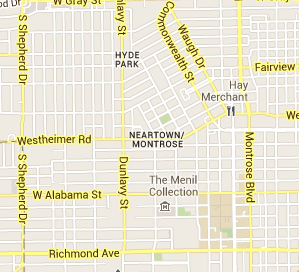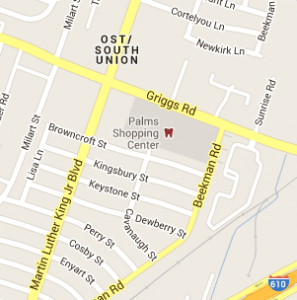Keep Houston Houston has had enough of “fake” neighborhood names.
“Lower Westheimer” – This does not actually exist, it’s just Montrose. Or “The Montrose” if you wish to rebel against popular linguistic conventions without going full retard.
“Neartown” – This also does not exist, it’s just Montrose. This appears to have been an 80′s or 90′s era attempt to rebrand Montrose as something other than Montrose, and only appears on official documents. Even the Realtors don’t use it, and Realtors tend to be on the forefront of linguistic murderation (see: “Craftsman”). It should be scrubbed completely from the record.
“Washington Heights” – Again, this does not actually exist. There are legitimate grounds for nitpicking over what to call the small finger of the original Heights plat that extends south of IH-10, but this is a miniscule area – and in any event, if it’s part of The Heights, then it is simply The Heights. If you live off Washington, you live off Washington. If you live in an area covered by another historical name, like “Rice Military” or “Cottage Grove,” that works too – although I’ve always tended to look askance at people who use sub-neighborhood names. It’s as if they’re too elitist for general neighborhood or street names. “Oh you live in Avondale? Tell me more.” However, Washington Heights is right out.
“EaDo” – Seriously? No. No, no, no, no, no. The proliferation of faux New York City style names needs to stop, and it might as well stop here. You can say “Eastside,” or you can say “Third Ward.” There’s no other cutesy names to mine from (like “Cottage Grove”) because historically speaking, no one lived there.
Now, some might argue that this isn’t actually Third Ward. These people are wrong. If you want to see what is and isn’t the Third Ward, walk into Ninfa’s on Navigation and scope the map they’ve got hanging up front by the waitstand. Now find the area to the immediate east of Downtown. See what ward it’s in? Yep. You in the Tre, homie. You too, Eastwood.
“OST / South Union” – This is another one of those names, like “Neartown,” that appears to have been an attempt at top-down rebranding when the Super Neighborhoods were drawn up. But everything west of Cullen and south of Griggs is pretty clearly “Yellowstone” (or “The Yellowstone”), and with all the development focused on Palm Center this will probably end up being the default name for the Griggs/MLK intersection, which was originally part of the South Park plats. There is no other unclaimed land to apply this moniker to, so let’s throw it out along with the rest of ‘em.
I grew up on Staten Island, the last and least of New York City’s five boroughs. To the rest of the world, we simply say we’re from the Island when asked of our origins, but to fellow Islanders we say what neighborhood we’re from. The local newspaper, the Staten Island Advance, is obsessively meticulous about identifying the neighborhood for each person, business, or event it reports on. A part of my eighth grade social studies curriculum was the history and geography of New York City in general, and of Staten Island in particular. Our teacher, Mr. Kapacinski, showed us a map of the Island with each neighborhood detailed. I don’t recall if we were ever tested on that, which is just as well because there’s dozens of those neighborhoods and you can drive yourself crazy trying to remember where Castleton Corners ends or where Dongan Hills begins, but there was a time when I was reasonably proficient with it.
The thing about that map, though, is that it was completely subjective. No one had ever done an official survey and determined exact boundary lines. As Mr. Kapacinski told us, each neighborhood was what the people that lived there called it. Any Islander worth her salt can tell you what her own neighborhood is, but only the most hardcore can say with confidence what and who else is or is not in that neighborhood. Some older neighborhoods like Tottenville or Stapleton, one-time home of the Stapes, are fairly well-defined, but thanks to the housing boom that followed the construction of the Verrazano Bridge in 1964, there’s a whole lot of people living in places that were once empty. Those places needed to be called something, and as there’s no Department Of Neighborhood Names to rely on, what they decided to call themselves is what the rest of us now call them. If that area used to be known as something else back before it was developed, well, that’s the way it goes.
This is all a very long-winded way of saying that I disagree with Keep Houston Houston on this. Frankly, given how dynamic and ever-reinventing Houston is, I don’t see the point in saying that there is none but The Heights or The Montrose or The Third Ward, and any newfangled names are an abomination before me. Sure, some of these names are shameless attempts to glom onto the cachet of an area that has never extended to that particular location before – there’s a reason why every development on the outskirts of The Heights calls itself Something Heights – but it does at least serve the purpose of pinpointing where it is. The Third Ward is a pretty expansive place, encompassing a lot of what now really are separate and distinct neighborhoods. I don’t think anyone objects to the moniker “the Museum District”, even though it’s technically in the Third Ward. Why should EaDo be excluded from polite conversation? It maybe too cute a name for one’s tastes, but it’s nowhere close to the Museum District in location or character. Let it be its own place, I say. And if next month someone plans an EaDo Heights development – that big former KBR property is going to be called something else someday – I can live with that, too.
Note, by the way, the embedded pictures above. They’re clipped from Google Maps, the result of searching for “Neartown, Houston” and “OST/South Union, Houston”. With all due respect to KHH, if Google says something exists, I say that’s a pretty strong prima facie case for it. I’ll stipulate that the others remain figments, at least for now, but thirty years on I’ll stick with Mr. Kapacinski’s rule: A neighborhood is what the people there call it. You may not like the names they’ve picked, but as with old school grammarians and the word ain’t, it’s a fight you’re going to lose.
Since I started writing this post, KHH posted a followup that was largely in response to this riposte from John Nova Lomax at Houstonia. KHH takes the beginning premise in some other directions, and since I don’t want to rewrite all this from scratch I’ll just leave that be. Really, I just wanted to say that one can’t dictate neighborhood names, and that especially in a city that changes as much as Houston does you should expect the names to change as well. Finally, if your objection is that a lot of these new names are just marketing efforts by realtors and/or developers, isn’t that how most of the old neighborhoods got their names, too? If the likes of “EaDo” and “Washington Heights” really are ephemeral, then in the fullness of time we’ll all forget they ever existed. If not, who cares how they came to be named?



I have to side with KHH on this.
I’ve lived in New York as well and what differentiates this alarming trend in Houston from New York’s fungible neighborhood lines is that New York’s neighborhoods, because of that city’s density, are better established and more historically congruent.
Take Hell’s Kitchen. That Westside of Midtown Manhattan neighborhood has been through at least 2 City Hall/Realtor renamings (Midtown West, Clinton) and yet nothing sticks because in a way the city cannot erase what people remember and where people grew up. No one ever grew up in Midtown West. They grew up in Hell’s Kitchen.
In Houston however, the new arrivals and the impermanence of many of the city’s features sort of makes this neighborhood name rejiggering at times confusing, at other times misleading.
I have resorted to asking people what major intersection they live near to figure out what part of town they live in as “Museum District” apparently now starts at the Menil and ends on MacGregor and Scott. Or “The Heights” is now everything in the First Quadrant (see how I just made that up) of the city’s grid (Everything in the Loop North of I-10 and West of I-45).
And while I understand the attempt to latch onto fancy-sounding names to try to increase the desirability of a neighborhood ( See: Kirby, Upper), that crap is annoying when they no longer have a relationship to reason or geography (See Uptown, on the Westside of town.); and it is truly problematic when it succeeds in erasing historical (usually minority) neighborhoods entirely (Midtown, formerly Little Saigon. Eado, formerly Chinatown.)
tl;dr: change is hard
This made my day! I live w/in walking distance to Ninfas (one of my favorite restaurants), but never considered it 3rd Ward. Now I know! LOL @ “The Tre, homie!” HAHAAA